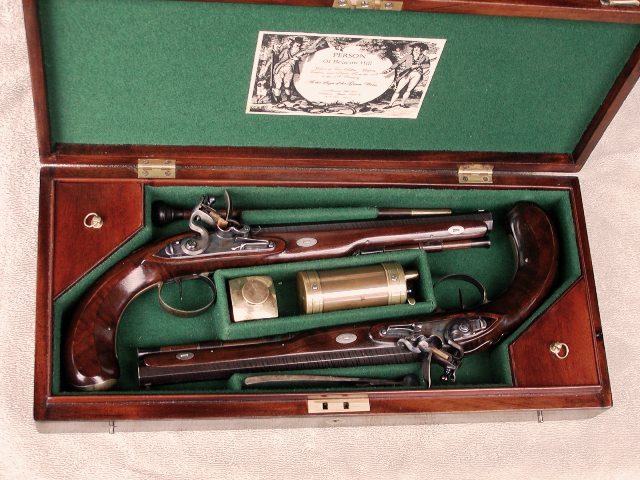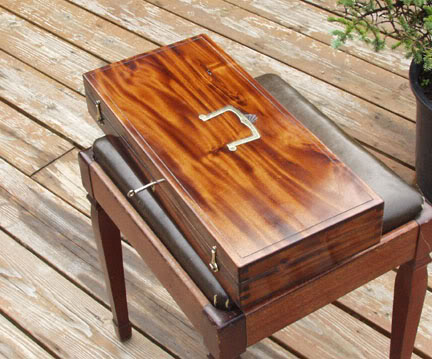the first try, blue-eyed, after long research for the right glue ( it's hasenleim; made from rabbit skin and bones) the interior I had made before, of course not the guns and the powder bottle, the latter only got an original Tiffany-patina, but ramrod, the ebony boxes, hammer, handles for the screwdriver/piston-tool and the bronze parts are self-made on my small chinese lathe.
On the last picture the next project with my two pistols from gunsmith Bössel / Suhl germany.
Very interesting weapons by the way; there is a thorn in the powder magazine.
The spike rifle is a special rifle construction. It is a multiloading rifle with a pulled barrel.
The construction was proposed in 1844 by the French colonel Thouvenin, as an improvement of the system by Henri Gustave Delvigne. The long projectile is raised with the ramrod on a steel spike attached to the base of the tail bolt. This enlarges the calibre of the lead bullet, so that it takes the pulls during the shot and is thus set in rotation. The French army introduced this system in 1846, followed by Sardinia, Denmark and Norway.
Thouvenin's design was an improvement over Delvigne's, but it did not work satisfactorily either. Firstly, the bullet was unevenly deformed by the blows with the ramrod, which resulted in poor precision. It was also difficult to clean the chamber around the spike, which caused rust. The rust, together with the high temperatures during firing and the repeated blows of the ramrod caused frequent breakage of the spike.
In the town of Suhl/Thuringia/ Germany several hundred rifles and also pistols were manufactured for the Swedish cavalry.
Probably an officer had this, my pistol pair, manufactured.
On the last picture the next project with my two pistols from gunsmith Bössel / Suhl germany.
Very interesting weapons by the way; there is a thorn in the powder magazine.
The spike rifle is a special rifle construction. It is a multiloading rifle with a pulled barrel.
The construction was proposed in 1844 by the French colonel Thouvenin, as an improvement of the system by Henri Gustave Delvigne. The long projectile is raised with the ramrod on a steel spike attached to the base of the tail bolt. This enlarges the calibre of the lead bullet, so that it takes the pulls during the shot and is thus set in rotation. The French army introduced this system in 1846, followed by Sardinia, Denmark and Norway.
Thouvenin's design was an improvement over Delvigne's, but it did not work satisfactorily either. Firstly, the bullet was unevenly deformed by the blows with the ramrod, which resulted in poor precision. It was also difficult to clean the chamber around the spike, which caused rust. The rust, together with the high temperatures during firing and the repeated blows of the ramrod caused frequent breakage of the spike.
In the town of Suhl/Thuringia/ Germany several hundred rifles and also pistols were manufactured for the Swedish cavalry.
Probably an officer had this, my pistol pair, manufactured.
Attachments
-
 1Kasten 1200 x .jpg271.1 KB · Views: 151
1Kasten 1200 x .jpg271.1 KB · Views: 151 -
 ausgesägter Einsatz 1200 x.JPG123.3 KB · Views: 145
ausgesägter Einsatz 1200 x.JPG123.3 KB · Views: 145 -
 erster Stoff 1200 x.jpg152.2 KB · Views: 127
erster Stoff 1200 x.jpg152.2 KB · Views: 127 -
 Kasten Fach 1200 x.jpg201.4 KB · Views: 141
Kasten Fach 1200 x.jpg201.4 KB · Views: 141 -
 Kasten offen mit Deckel 1200 x .jpg158.2 KB · Views: 133
Kasten offen mit Deckel 1200 x .jpg158.2 KB · Views: 133 -
 nächstes Projekt 1200 x.jpg134.7 KB · Views: 130
nächstes Projekt 1200 x.jpg134.7 KB · Views: 130 -
 Thouvenin.jpg21.6 KB · Views: 135
Thouvenin.jpg21.6 KB · Views: 135









